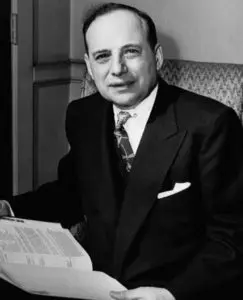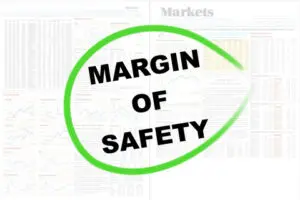Warren Buffett, arguably the greatest investor of all time, was the only student to whom professor Ben Graham gave an A+ for the course he taught on security analysis at Columbia University. Buffett later worked for Graham for a couple of years. Graham was a teacher, a mentor, and a friend to Buffett. Buffett said about Ben Graham’s The Intelligent Investor:
Chapters 8 and 20 have been the bedrock of my investing activities for more than 60 years. I suggest that all investors read those chapters and reread them every time the market has been especially strong or weak.
(Ben Graham, by Equim43 via Wikimedia Commons)
CHAPTER 8: THE INVESTOR AND MARKET FLUCTUATIONS
Graham notes that stock prices fluctuate widely, and the intelligent investor should be interested in profiting from these swings. Graham says there are two ways to do this: timing and pricing. Timing is an attempt to predict stock prices. Graham:
By pricing we mean the endeavor to buy stocks when they are quoted below their fair value and to sell them when they rise above such value.
Note that fair value, also called intrinsic value, is how much a knowledgeable buyer would pay for a business, based either upon how much the business can earn or based upon the balance sheet of the business.
Graham continues by noting that trying to time the market is speculation, and will not result in profits over the long term. Many investors feel compelled to listen to stock market forecasts. But, says Graham:
There is no basis either in logic or in experience for assuming that any typical or average investor can anticipate market movements more successfully than the general public, of which he is himself a part.
This is understating the case. There is no evidence that any individual forecaster has been able to consistently predict the short-term movements of the stock market.

Graham points out that one factor that leads the speculator to rely on shorter-term stock market predictions is that the speculator is in a hurry to make money. An investor, by contrast, does not mind waiting one year or several years for a sound investment to pay off.
Furthermore, timing formulas based on the past tend not to work as well in the future, as Graham explains:
Those formulas that gain adherents and importance do so because they have worked well over a period, or sometimes merely because they have been plausibly adapted to the statistical record of the past. But as their acceptance increases, their reliability tends to diminish. This happens for two reasons: First, the passage of time brings new conditions which the old formula no longer fits. Second, in stock-market affairs the popularity of a trading theory has itself an influence on the market’s behavior which detracts in the long run from its profit-making possibilities.
Graham writes of several theories that tried to identify buying conditions and selling conditions in the market. Even Graham himself developed a “central value method.” However, says Graham:
The moral seems to be that any approach to moneymaking in the stock market which can be easily described and followed by a lot of people is by its terms too simple and too easy to last.
An an investor, one should expect wide fluctuations in stock prices. But what do you do after stock prices have advanced a great deal? Graham:
But has the price risentoo high, and should you think of selling? Or should you kick yourself for not having bought more shares when the level was lower? Or–worst thought of all–should you now give way to the bull-market atmosphere, become infected with the enthusiasm, the overconfidence and the greed of the great public (of which, after all, you are a part), and make larger and dangerous commitments? Presented thus in print, the answer to the last question is a self-evident no, but even the intelligent investor is likely to need considerable will power to keep from following the crowd.
Graham continues:
It is for these reasons of human nature, even more than by calculation of financial gain or loss, that we favor some kind of mechanical method for varying the proportion of bonds to stocks in the investor’s portfolio. The chief advantage, perhaps, is that such a formula will give himsomething to do. As the market advances he will from time to time make sales out of his stockholdings, putting the proceeds into bonds; as it declines he will reverse the procedure. These activities will provide him some outlet for his otherwise too-pent-up energies. If he is the right kind of investor he will take added satisfaction from the thought that his operations are exactly opposite from those of the crowd.
Business Valuations versus Stock-Market Valuations
Graham writes:
The impact of market fluctuations upon the investor’s true situation may be considered also from the standpoint of the shareholder as the part owner of various businesses. The holder of marketable shares actually has a double status, and with it the privilege of taking advantage of either at his choice. On the one hand his position is analogous to that of a minority shareholder or silent partner in a private business. Here his results are entirely dependent on the profits of the enterprise or on a change in the underlying value of its assets. He would usually determine the value of such a private-business interest by calculating his share of the net worth as shown in the most recent balance sheet. On the other hand, the common-stock investor holds a piece of paper, an engraved stock certificate, which can be sold in a matter of minutes at a price which varies from moment to moment–when the market is open, that is–and often is far removed from the balance-sheet value.
Graham goes on to note that many successful businesses sell above their net worth. (Note that net worth is also called book value, balance-sheet value, asset value, net asset value, and tangible book value.) In this sense, Graham considers such businesses speculative as compared to unspectacular businesses selling at book value or below. (It should be noted that businesses with a sustainably high ROIC–return on invested capital–should sell above book value. Some successful technology companies fall into this category.)
Graham:
The previous discussion leads us to a conclusion of practical importance to the conservative investor in common stocks. If he is to pay some special attention to the selection of his portfolio, it might be best for him to concentrate on issues selling at a reasonably close approximation to their tangible-asset value–say, at not more than one-third above that figure. Purchases made at such levels, or lower, may with logic be regarded as related to the company’s balance sheet, and as having a justification or support independent of the fluctuating market prices….
(Illustration byTeguh Jati Prasetyo)
Graham adds:
A caution is needed here. A stock does not become a sound investment merely because it can be bought at close to its asset value. The investor should demand, in addition, a satisfactory ratio of earnings to price, a sufficiently strong financial position, and the prospect that its earnings will at least be maintained over the years. This may appear like demanding a lot from a modestly priced stock, but the prescription is not hard to fill under all but dangerously high market conditions. Once the investor is willing to forgo brilliant prospects–i.e., better than average expected growth–he will have no difficulty in finding a wide selection of issues meeting these criteria.
Graham then makes a central point:
The investor with a stock portfolio having such book values behind it can take a much more independent and detached view of stock-market fluctuations than those who have paid high multiples of both earnings and tangible assets. As long as the earning power of his holdings remains satisfactory, he can give as little attention as he pleases to the vagaries of the stock market. More than that, at times he can use these vagaries to play the master game of buying low and selling high.
The A. & P. Example
Graham gives the example of the Great Atlantic & Pacific Tea Co. The shares sold as high as $494 in 1929, and ended up declining to a new low of $36 in 1938. At that price, the company had a market capitalization of of $126 million, which was lower than its net current assets of $134 million. Essentially, the company was selling below net cash, which is cash minus all liabilities. So its value as a going concern was lower than its value in a liquidation would be. Graham explains:
Why? First, because there were threats of special taxes on chain stores; second, because net profits had fallen off in the previous year; and, third, because the general market was depressed. The first of these reasons was an exaggerated and eventually groundless fear; the other two were typical of temporary influences.
What about the investor who bought at $80 in 1937? Graham says the investor should carefully have studied the situation, but should have concluded that the market price was a temporary vagary. In fact, the investor should have bought more if he had the funds and the courage to do so.
By 1939, A. & P. was selling at $117.5. In the years following 1949, A. & P. continued to advance, eventually reaching a split-adjusted price of $705. At that price, the stock had a price-to-earnings ratio of 30, which implied that holders of the stock expected brilliant growth. Such expectations were not justified. The stock fell to an equivalent of $340, but even then was still not a bargain. Eventually if fell to the equivalent of $215 in 1970 and then $180 in 1972, when the company reported its first quarterly loss in its history.
Graham comments:
We see in this history how wide can be the vicissitudes of a major American enterprise in little more than a single generation, and also with what miscalculations and excesses of optimism and pessimism the public has valued its shares.
Graham concludes:
There are two chief morals to this story. The first is that the stock market often goes far wrong, and sometimes an alert and courageous investor can take advantage of its patent errors. The other is that most businesses change in character and quality over the years, sometimes for the better, perhaps more often for the worst. The investor need not watch his companies’ performance like a hawk; but he should give it a good, hard look from time to time.
Graham returns to the idea that a holder of marketable shares is like someone who owns a private business:
The true investor scarcely everis forced to sell his shares, and at all other times he is free to disregard the current price quotation. He need pay attention to it and act upon it only to the extent that it suits his book, and no more. Thus the investor who permits himself to be stampeded or unduly worried by unjustified market declines in his holdings is perversely transforming his basic advantage into a basic disadvantage. That man would be better off if his stocks had no market quotation at all, for he would then be spared the mental anguish caused him byother persons’ mistakes of judgment.
Graham then introduces the concept of “Mr. Market.” Imagine you own a share in a private business:
One of your partners, named Mr. Market, is very obliging indeed. Every day he tells you what he thinks your interest is worth and furthermore offers either to buy you out or to sell you an additional interest on that basis. Sometimes his idea of value appears plausible and justified by business developments and prospects as you know them. Often, on the other hand, Mr. Market lets his enthusiasm or his fears run away with him, and the value he proposes seems to you a little short of silly.
Graham makes the point that you do not form your opinion about the value of the business based on Mr. Market’s daily communication:
Only in case you agree with him, or in case you want to trade with him. You may be happy to sell out to him when he quotes you a ridiculously high price, and equally happy to buy from him when his price is low. But the rest of the time you will be wiser to form your own ideas of the value of your holdings, based on full reports from the company about its operations and financial position.
Graham argues that owning a share of stock is similar to the Mr. Market analogy:
Basically, price fluctuations have only one significant meaning for the true investor. They provide him with an opportunity to buy wisely when prices fall sharply and to sell wisely when they advance a great deal. At other times he will do better if he forgets about the stock market and pays attention to his dividend returns and to the operating results of his companies.
(Illustration by Andrii Vinnikov)
Graham concludes:
The investor with a portfolio of sound stocks should expect the prices to fluctuate and should neither be concerned by sizable declines nor become excited by sizable advances. He should always remember that market quotations are there for his convenience, either to be taken advantage of or to be ignored. He should never buy a stockbecauseit has gone up or sell onebecauseit has gone down.
Graham makes one final point:
Good managements produce a good average market price, and bad managements produce bad market prices.
CHAPTER 20: “MARGIN OF SAFETY” AS THE CENTRAL CONCEPT OF INVESTMENT
Graham writes:
In the old legend the wise men finally boiled down the history of mortal affairs into the single phrase, “This too will pass.” Confronted with a like challenge to distill the secret of sound investment into three words, we venture the motto, MARGIN OF SAFETY.
Graham comments:
Here the function of the margin of safety is, in essence, that of rendering unnecessary an accurate estimate of the future. If the margin is a large one, then it is enough to assume that future earnings will not fall far below those of the past in order for an investor to feel sufficiently protected against the vicissitudes of time.
Graham again:
The margin of safety is always dependent on the price paid. It will be large at one price, small at some higher price, nonexistent at some still higher price.
(Photo by Chuahtc8)
Graham explains margin of safety:
The margin-of-safety idea becomes much more evident when we apply it to the field of undervalued or bargain securities. We have here, by definition, a favorable difference between price on the one hand and indicated or appraised value on the other. That difference is the margin of safety. It is available for absorbing the effect of miscalculations or worse than average luck. The buyer of bargain issues places particular emphasis on the ability of the investment to withstand adverse developments. For in most such cases he has no real enthusiasm about the company’s prospects.
Graham goes on to note that a moderate decline in earnings power will not necessarily prevent a cheaply bought stock from producing a satisfactory investment result.
A Criterion of Investment versus Speculation
Graham writes:
Probably most speculators believe they have the odds in their favor when they take their chances, and therefore they may lay claim to a safety margin in their proceedings… But such claims are unconvincing. They rest on subjective judgment, unsupported by any body of favorable evidence or any conclusive line of reasoning. We greatly doubt whether the man who stakes money on his view that the market is heading up or down can ever be said to be protected by a margin of safety in any useful sense of the phrase.
Graham observes that, by contrast, buying stocks below a conservative appraisal of intrinsic value does imply a margin of safety and therefore does classify as investment rather than speculation.
To Sum Up
Graham sums up the chapter:
Investment is most intelligent when it is most businesslike. It is amazing to see how many capable businessmen try to operate in Wall Street with complete disregard of all the sound principles through which they have gained success in their own undertakings. Yet every corporate security may best be viewed, in the first instance, as an ownership interest in, or a claim against, a specific business enterprise. And if a person sets out to make profits from security purchases and sales, he is embarking on a business venture of his own, which must be run in accordance with accepted business principles if it is to have a chance of success.
Graham says the investor should know as much about the intrinsic values of the businesses in which he invests as he would need to know about the value of merchandise that he proposed to manufacture and sell.
Graham adds that the investor should be able to supervise adequately the running of the business in which he invests, and the investor should have confidence in the integrity and ability of the managers running the business.
Moreover, the investor should have a reasonable chance of profit, while possible losses should be minimal by comparison.
Furthermore, notes Graham, have the courage of your knowledge and experience, regardless of how many others agree or disagree.
You are neither right nor wrong because the crowd disagrees with you. You are right because your data and reasoning are right… in the world of securities, courage becomes the supreme virtueafter adequate knowledge and a tested judgment are at hand.
BOOLE MICROCAP FUND
An equal weighted group of micro caps generally far outperforms an equal weighted (or cap-weighted) group of larger stocks over time. See the historical chart here: https://boolefund.com/best-performers-microcap-stocks/
This outperformance increases significantly by focusing on cheap micro caps. Performance can be further boosted by isolating cheap microcap companies that show improving fundamentals. We rank microcap stocks based on these and similar criteria.
There are roughly 10-20 positions in the portfolio. The size of each position is determined by its rank. Typically the largest position is 15-20% (at cost), while the average position is 8-10% (at cost). Positions are held for 3 to 5 years unless a stock approachesintrinsic value sooner or an error has been discovered.
The mission of the Boole Fund is to outperform the S&P 500 Index by at least 5% per year (net of fees) over 5-year periods. We also aim to outpace the Russell Microcap Index by at least 2% per year (net). The Boole Fund has low fees.
If you are interested in finding out more, please e-mail me or leave a comment.
My e-mail: jb@boolefund.com
Disclosures: Past performance is not a guarantee or a reliable indicator of future results. All investments contain risk and may lose value. This material is distributed for informational purposes only. Forecasts, estimates, and certain information contained herein should not be considered as investment advice or a recommendation of any particular security, strategy or investment product. Information contained herein has been obtained from sources believed to be reliable, but not guaranteed.No part of this article may be reproduced in any form, or referred to in any other publication, without express written permission of Boole Capital, LLC.





